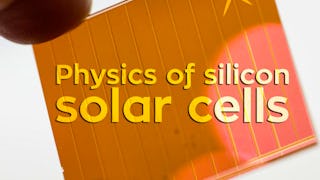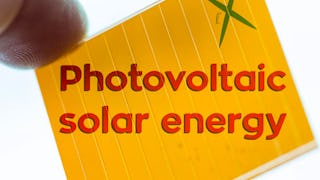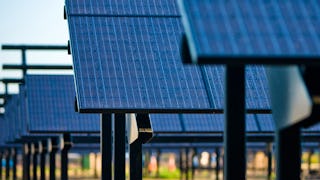How do solar cells work, why do we need, and how can we measure their efficiency? These are just some of the questions Introduction to solar cells tackles. Whether you are looking for general insight in this green technology or your ambition is to pursue a career in solar, “Introduction to Solar Cells” is an excellent starting point.


(2,516 reviews)
Skills you'll gain
Details to know

Add to your LinkedIn profile
45 assignments
See how employees at top companies are mastering in-demand skills

There are 11 modules in this course
In this introduction module I would like to introduce you to the course its content and teaching style. I hope you will enjoy the way we have designed the course.
What's included
1 reading
The first topic in an introduction course on solar cells is naturally a historical overview. In this module you will briefly get introduced to the history and early development of solar cells. We will also start to do some calculations of efficiency and energy output of solar cells.
What's included
2 videos5 readings5 assignments1 discussion prompt
The most important question one can ask must be: "Why is solar energy is an important topic and why should we develop solar energy?". This module does not claim to answer that question fully, but we will summarize the strong case for renewable energy.
What's included
3 videos5 readings4 assignments2 discussion prompts
How much power can a solar cell produce and how can we measure it? This question is the starting point for this module and we will go through the terminology, talk about light sources, and even measure a solar cell ourselves.
What's included
5 videos4 readings4 assignments1 discussion prompt
In this module we will introduce an equivalent circuit of a solar cell and use it to explain key concepts including short circuit current, open circuit voltage, parasitic resistances, and more. We will also talk about connected solar cells, and their behavior in shaded conditions.
What's included
2 videos5 readings4 assignments1 discussion prompt
In this module we will attack the topic: How do solar cells work? This module will be more theory heavy than other parts of the course, but don't worry. We will focus on the key concepts that are necessary to understand how solar cells work, and skip the math.
What's included
3 videos6 readings6 assignments1 discussion prompt
With a knowledge of the working principles of solar cells, we are now ready to apply this knowledge to understand why there are limits to the efficiency of solar cells. We will also briefly look into loss mechanisms that limit the practical efficiency.
What's included
2 videos4 readings4 assignments1 discussion prompt
Silicon solar cells are by far the most prevalent solar cell technology. In this module we will talk about why silicon is so abundant. We will also learn how silicon solar cells are made, what differentiates multi and monocrystalline silicon, and much more.
What's included
5 videos7 readings4 assignments1 discussion prompt
Moving beyond silicon solar cells, the next important development is thin film solar cells. In thin film solar cells, we see a potential solution to the major problem associated with silicon solar cells: namely energy payback time.
What's included
4 videos5 readings5 assignments1 discussion prompt
We will now turn to an example of a third generation solar cell technology: namely polymer solar cells. Polymer solar cells promise to solve all the problems we see with other technologies. They are cheap and fast to produce, they are non-toxic and use non-scarce materials, and they exhibit the lowest energy payback time of any technology. In this module we will learn about pros and cons of this interesting technology.
What's included
6 videos8 readings5 assignments1 discussion prompt
In our final module of this course we will look into a selection of solar cell technologies and spend some time comparing all the different solar cell technologies.
What's included
2 videos5 readings4 assignments1 discussion prompt
Instructor

Offered by
Explore more from Environmental Science and Sustainability
 Status: Preview
Status: PreviewÉcole Polytechnique

The State University of New York
 Status: Preview
Status: PreviewÉcole Polytechnique
 Status: Free Trial
Status: Free TrialUniversity at Buffalo
Why people choose Coursera for their career




Learner reviews
2,516 reviews
- 5 stars
80.84%
- 4 stars
17.17%
- 3 stars
1.55%
- 2 stars
0.23%
- 1 star
0.19%
Showing 3 of 2516
Reviewed on May 22, 2020
The course was interesting. it opened a new world for me to learn more. in the future, i will refer to this course whenever i have need of revising concepts related to this field.
Reviewed on Dec 11, 2017
Very concise and to the point. Stable and calm teaching. Was my first foray into renewable energy and absolutely loved it. The course instructor was brilliant and had a stable command over the topic.
Reviewed on Jul 30, 2021
This is a great course to learn about Solar cell and Solar cell manufacturing. I have learned a lot about this topic and I am excited to learn and work on solar cell technology

Open new doors with Coursera Plus
Unlimited access to 10,000+ world-class courses, hands-on projects, and job-ready certificate programs - all included in your subscription
Advance your career with an online degree
Earn a degree from world-class universities - 100% online
Join over 3,400 global companies that choose Coursera for Business
Upskill your employees to excel in the digital economy
Frequently asked questions
To access the course materials, assignments and to earn a Certificate, you will need to purchase the Certificate experience when you enroll in a course. You can try a Free Trial instead, or apply for Financial Aid. The course may offer 'Full Course, No Certificate' instead. This option lets you see all course materials, submit required assessments, and get a final grade. This also means that you will not be able to purchase a Certificate experience.
When you purchase a Certificate you get access to all course materials, including graded assignments. Upon completing the course, your electronic Certificate will be added to your Accomplishments page - from there, you can print your Certificate or add it to your LinkedIn profile.
Yes. In select learning programs, you can apply for financial aid or a scholarship if you can’t afford the enrollment fee. If fin aid or scholarship is available for your learning program selection, you’ll find a link to apply on the description page.
More questions
Financial aid available,

